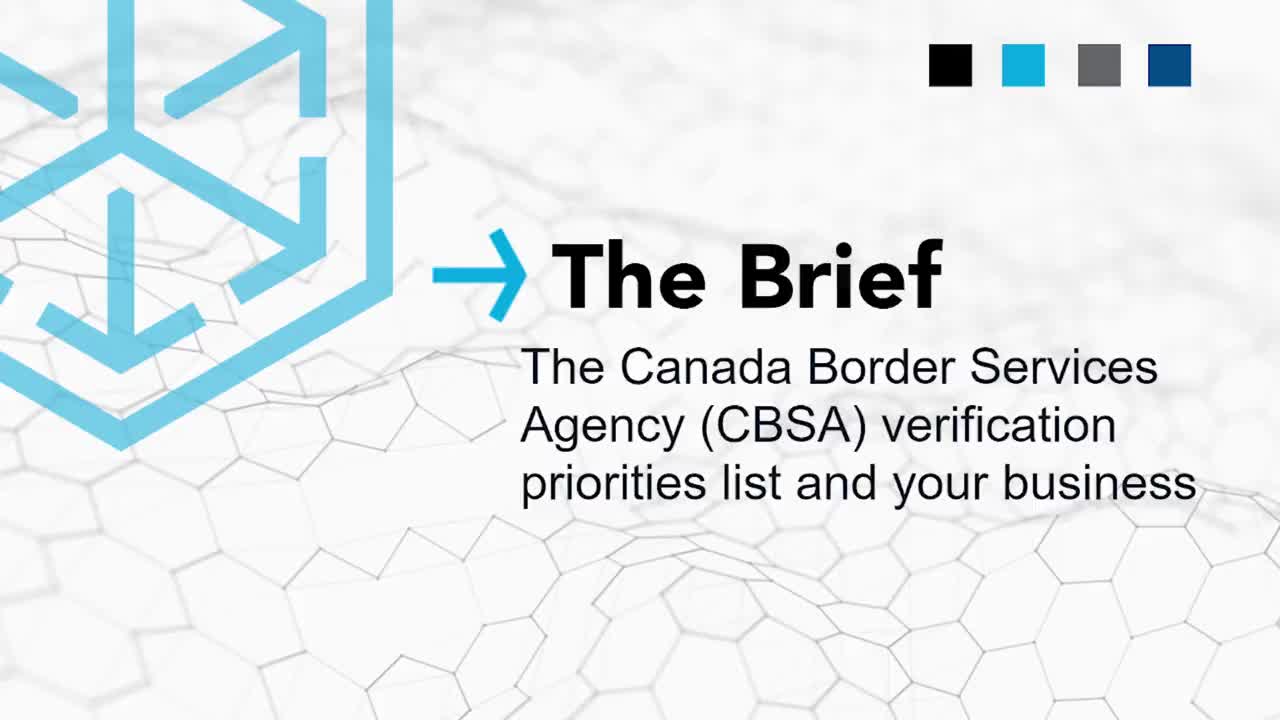Recent Trade & Tariff Perspectives
March 16, 2022 | Brad Hogeterp Product Development Manager

Published Canadian Audit Priorities in Focus: What to Expect and How to Proactively Prepare
It’s that time of year again with audits in the air. The Canada Border Services Agency (CBSA) tips their hand twice a year to Canadian importers by publishing an updated listing of their priorities in focus for customs auditing. This verification priorities list can be viewed as a bit of a wake-up call to Canadian importers who may be in the CBSA’s crosshairs for an audit. Don’t get caught off guard—read on to ensure you are adequately prepared.
Watch or listen to this week's Trade & Tariff Perspective:

CBSA trade compliance verifications: An overview
The CBSA frequently conducts audits of Canadian importers’ transactions in an effort to review and confirm the level of compliance in accordance with the Customs Act. Where the CBSA determines an importer to be non-compliant, the verification audit findings may result in administrative monetary penalties system (AMPS), required corrections, the potential payment of duties, as well as Goods & Services Tax (GST) owed on imported goods. Other areas of focus by the CBSA may include compliance and accuracy in conducting duty relief programs or other special programs and customs requirements.
The CBSA reviews industries and commodities with an evergreen risk assessment to determine if some areas pose a higher risk than others. Importers are often selected at random; however, the priority list is laser-focused on specific goods at issue. Many specific commodities have held camp on this list for years such as pasta, gloves, bags, and even cell phone cases.
Newcomers welcomed to the priority list this year are bicycle parts and certain parts of machinery. Arbitrary, this list is not. If you are considered a medium or large importer of these commodities, the likelihood of receiving an audit letter is high.
A closer look at the items in purview
The most recent list of verification priorities, as published by the CBSA, is captured below. This list contains 19 Harmonized System (HS) classification items and two valuation priorities. No origin priorities were listed for this issue.
| CBSA Verification Priorities: January 2022 | ||
|---|---|---|
| Chapter/Header | HS Classification Goods Description | Date Added |
| 02.07, 16.01, 16.02 | Spent fowl (Round 2) | July 2017 |
| 19.02 | Pasta (Round 3) | November 2015 |
| 20.01 | Pickled vegetables (Round 5) | June 2012 |
| 38.24 | Other chemical products | December 2018 |
| 39.26, 42.02, 85.17 | Cell phone cases (Round 3) | January 2016 |
| 42.02 | Bags (Round 2) | October 2017 |
| 42.03 | Gloves (Round 2) | July 2017 |
| 64.03 | Footwear valued at C$30 or more per pair (Round 4) | March 2014 |
| 73.22 | Air heater and hot air distributors (Round 2) | June 2018 |
| 83.02 | Other mounting and fitting, suitable for furniture (Round 2) | June 2018 |
| 84.31 | Parts for use with machinery of chapter 84 (Round 3) | June 2015 |
| 84.79 | Parts of machines and mechanical appliances | December 2018 |
| 85.06 | Batteries (Round 4) | November 2013 |
| 85.13 | Flashlights and miners’ safety lamps (Round 2) | June 2018 |
| 85.39 | LED lamps | May 2020 |
| 87.14 | Bicycle parts (Round 3) | April 2015 |
| 94.03 | Stone table and counter tops (Round 2) | March 2016 |
| 94.01, 94.03 | Furniture for non-domestic purposes (Round 3) | January 2013 |
| 94.05 | Parts of lamps (Round 4) | September 2015 |
| Valuation | ||
| Chapters 61 and 62 | Apparel (Round 4) | February 2012 |
| Chapter 64 | Footwear (Round 2) | February 2012 |
Proactively prepare for an upcoming audit focus
Canadian importers shipping goods listed under the above-mentioned descriptions and numbers may look to consider an internal review and take a proactive approach in assessing or potentially correcting highlighted areas of concern.
Often, a simple correction is the answer but may involve the submission of a voluntary disclosure to the CBSA. The potential for AMPS penalties from an upcoming audit can often be minimized by addressing corrections in a timely and proactive manner.
Looking for guidance on next steps to take?
Get started on the right foot. Find an experienced, compliance-minded consulting partner when working with C.H. Robinson’s trade policy experts. Our group of knowledgeable individuals can guide you through a strategic review and assessment of your potential Canadian import transactions in focus, identify risk exposures, and deliver a plan of action to uphold your compliance goals. Connect with one of our trade policy experts to learn more.
Resources
Review recent perspectives
- March 2 | Customs and Trade Policy Developments We’re Following This Month
- February 16 | Transporting goods inside Mexico. Are you complying with Complemento Carta Porte?
- February 2 | Canada to U.S. Shipments: Your Guide to Reducing Import Costs
- January 19 | Importing into the United States from Canada? Here’s What You Need to Know
